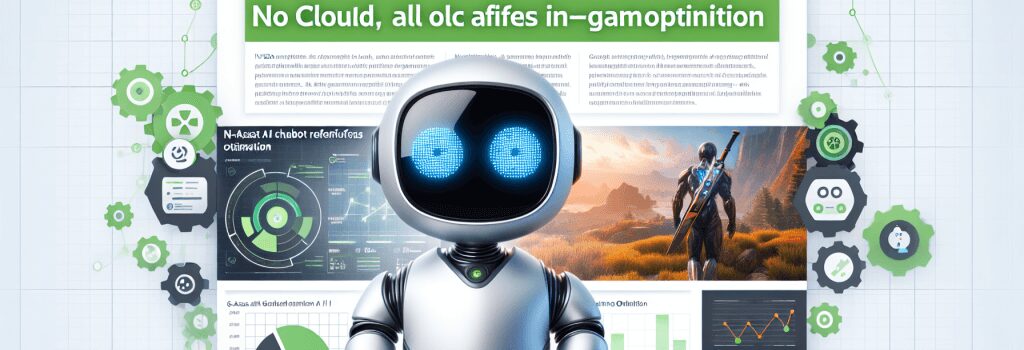No Cloud, All Local: Nvidia’s G-Assist AI Chatbot Redefines In-Game Optimization

Nvidia has historically revolutionized the gaming world with its high-performance GPUs. Now, they are taking a significant stride into the realm of on-device artificial intelligence with G-Assist, an experimental AI chatbot designed primarily for gamers. Unlike many AI tools that rely on cloud computing, G-Assist runs locally on your GPU, ensuring faster interactions and keeping sensitive data on your machine.
Local AI on Your GPU: How It Works
G-Assist runs within the Nvidia desktop app as a floating overlay that gamers can invoke during gameplay. Users can interact with the AI either by typing or using voice commands. At its core, G-Assist utilizes a small language model (SLM) optimized for local operation – the basic installation requires 3GB, while enhanced voice control bumps that number to 6.5GB. This local processing framework eliminates dependence on remote servers, reducing latency and potential privacy concerns.
- System Monitoring: Receive real-time status updates and custom data charts on system performance.
- Dynamic Tweaks: Ask G-Assist to adjust system-level settings, optimize game performance, or even overclock your GPU—with graphical insights into expected performance gains.
- Integrated Control: Direct commands can control settings on third-party peripherals, including MSI motherboards, Logitech G devices, Corsair, and Nanoleaf systems.
Technical Specifications and Hardware Requirements
G-Assist is tailored for the serious gamer with a high-performance machine. It currently requires a GeForce RTX 30, 40, or the latest 50 series GPU with a minimum of 12GB VRAM. This ensures that the simultaneous execution of gaming processes and AI inference does not severely hamper performance. However, early tests with the RTX 4070 reveal that while G-Assist is feature-rich, running inference on the GPU can spike its usage. In benchmark tests with demanding titles like Baldur’s Gate 3, performance dips of approximately 20% in FPS were noted during active G-Assist processing.
Performance Trade-offs and Current Limitations
While the idea of integrated on-device AI is innovative, current implementations of G-Assist come with performance trade-offs. Gamers using mid-to-high-end setups might notice a drop in FPS during AI interactions, although non-gaming contexts see faster response times. The challenges of running simultaneous processes on the same GPU highlight the need for further optimization in future updates. As Nvidia continues to refine this technology, it remains clear that the present version is more of an experimental tool rather than a mission-critical assistant for optimal gaming performance.
Third-Party Integration and Game-Centric Features
Nvidia initially demoed G-Assist with deep game integration features, including active in-game advice such as directional tips and performance optimization suggestions. Although the public release has limited game support — with titles such as Ark: Survival Evolved among the few integrated — the developers have opened the door for third-party plug-ins. These integrations extend control over connected peripherals, such as influencing thermal profiles via MSI hardware or altering LED settings on Logitech devices. This modular approach opens up numerous possibilities for gaming-enhancement tools that could eventually unify system optimization with dynamic gameplay assistance.
The Promise of On-Device AI: Industry Perspectives
G-Assist represents a forward-thinking movement in the tech community where local device performance meets advanced AI. Experts highlight that while cloud-based AI has dominated due to its scalable power and ease of updates, on-device AI promises lower latencies and enhanced security. With manufacturers racing to release AI-enabled laptops, Nvidia’s focus on premium GPUs underscores a niche market where dedicated hardware can handle both high-end gaming and advanced AI computations simultaneously.
Challenges and Future Prospects
Despite its innovative approach, G-Assist is still in an experimental phase. Current bugs and performance issues suggest that it isn’t yet a must-use feature for every gamer. However, industry analysts believe that such experiments pave the way for future generations of GPUs that can handle intricate AI models without compromising game performance. The evolution of this technology could lead to more immersive, reactive, and user-friendly gaming experiences that merge system optimization with real-time game strategy.
Expert Opinions and Closing Thoughts
Industry veterans and tech analysts alike are intrigued by the potential of running complex language models locally. Many believe that Nvidia’s choice to focus on gamers capitalizes on the lucrative intersection of high-performance hardware and AI innovation. However, experts caution that until further optimization, users may prefer manual configurations over relying too heavily on G-Assist’s experimental functions. The move signals a broader transition towards local AI adoption and could ultimately reshape how gamers and tech enthusiasts interact with their hardware.
In conclusion, Nvidia’s G-Assist is a bold experiment that blurs the lines between gaming and AI-driven system management. While still in its infancy and facing performance challenges, it offers a glimpse into a future where on-device AI is an integral part of the gaming ecosystem.